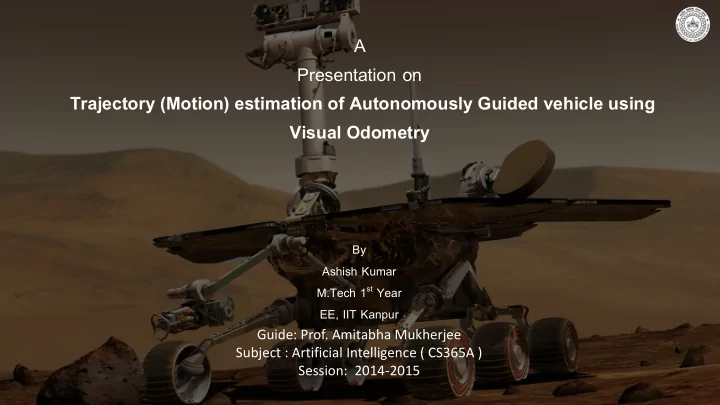

A Presentation on Trajectory (Motion) estimation of Autonomously Guided vehicle using Visual Odometry By Ashish Kumar M.Tech 1 st Year EE, IIT Kanpur Guide: Prof. Amitabha Mukherjee Subject : Artificial Intelligence ( CS365A ) Session: 2014-2015
Trajectory (Motion) estimation of Autonomously Guided vehicle using Visual Odometry • Odometry: Odometry is process of finding motion parameters using information from various kinds of sources like IMUs, optical encoders. • Visual Odometry: When the sensor used in odometry process is a visual sensor ( camera) ,then it is called Visual odometry INPUT OUTPUT Image Courtesy: DavideScaramuzza@ieee.org
• Aim: To find camera poses from set of images taken at discrete interval • How do we do that: We have to find a Transormation matrix which relates two image frames i.e. how the two frames are rotated and translated from each other. let set of images be { 𝐽 0 , 𝐽 1 , 𝐽 2….. 𝐽 𝑙−1, 𝐽 𝑙 } ,camera poses be {𝐷 0 , 𝐷 1 , 𝐷 2….. 𝐷 𝑙−1, 𝐷 𝑙 } and transformation matrix is given by 𝑙,𝑙−1 = 𝑆 𝑙,𝑙−1 𝑢 𝑙,𝑙−1 𝑈 0 1 where: 𝑈 𝑙,𝑙−1 is homogenous transformation matrix between images 𝐽 𝑙 and 𝐽 𝑙−1 . 𝑆 𝑙,𝑙−1 , 𝑢 𝑙,𝑙−1 are rotation and translation matrix between images 𝐽 𝑙 and 𝐽 𝑙−1 .
Image Courtesy: “ Learning OpenCV , O’REILLY”
Alogorithm Feature detection (SIFT/SURF/FAST) Feature Matching Outlier Removal using RANSAC Estimate motion using Essential Matrix X Windowed bundle Adjustment ( optional )
• A snap shot of my Application: 1 st image shows inliers ,outliers both. 2 nd image shows only inliers after using RANSAC. Matches Before RANSAC Matches After RANSAC
Motion Estimation: Motion estimation is done by finding Essential matrix , which is composed of 𝑆 𝑙,𝑙−1 , 𝑢 𝑙,𝑙−1 . 0 −𝑢 𝑨 𝑢 𝑧 𝑢 𝑨 0 −𝑢 𝑦 𝐹 = 𝑆 𝑙,𝑙−1 −𝑢 𝑧 𝑢 𝑦 0 “E” matrix can be computed using various methods like RANSAC, Normalized 8 point algorithm, Normalized 7 point algorithm, Nister’s 5 point algorithm. I have used RANSAC in conjunction with Normalized 8 point algo. Then ‘E’ is decomposed into above to matrices using SVD and then we have ‘R’ and ‘t’ matrix and we can form ‘T’ matrix from it.
Camera Pose: Now Concatenate all the transformation matrices. let 𝐷 𝑙 be current pose then 𝐷 𝑙 = 𝑈 𝑙,𝑙−1 * 𝐷 𝑙−1 Image Courtesy: “Visual Odometry: Part I - The First 30 Years and Fundamentals”
Various Frames of References: Image Courtesy: “The KITTI V ision Benchmark suite”
Acceleration, Velocity, X, Y, Z:
Some Pictures of results Results of program written in MATLAB Ground truth Results of program written in Visual Basic with EmguCV
Data Set: 1. Karlsruhe institute of Technology, Chicago (Technogical research institute of TYOTA for Autonoumous vehicles) 2. Raw 443 unrectified gray scale images of size 1392 x 512 of .png format. 3. Images are captured in City. Softwares Used: 1. MATLAB 2013, MathWorks. 2. Visual Studio 2013 Express Edition for Visual Basic. 3. EmguCV , a .NET wrapper of OpenCV binaries. References: [1]. Andreas Geiger, Philip Lenz, Christoph Stiller and Raquel Urtasun. Vsion meets Robotics: The KITTI dataset. In Journal “ International Jouranl of Robotics Research” (IJRR); 2013 [2]. Scaramuzza, D., Fraundorfer, F., Visual Odometry: Part I - The First 30 Years and Fundamentals , IEEE Robotics and Automation Magazine, Volume 18, issue 4, 2011. [3]. Fraundorfer, F., Scaramuzza, D., Visual Odometry: Part II - Matching, Robustness, and Applications , IEEE Robotics and Automation Magazine, Volume 19, issue 1, 2012. [4] . David Niste ´ r, Member, IEEE , “An Efficient Solution to the Five-Point Relative Pose Problem” , IEEE TRANSACTIONS ON PATTERN ANALYSIS AND MACHINE INTELLIGENCE, VOL. 26, NO. 6, JUNE 2004 [5]. Multiple View Geometry in Computer Vision 2 nd Edition by Richard Hartley Australian National University, Canberra, Australia and Andrew Zisserman University of Oxford, UK [6]. H.C. Longuet, Higgins “A computer algorithm for reconstructing a scene from two projections” .
Recommend
More recommend